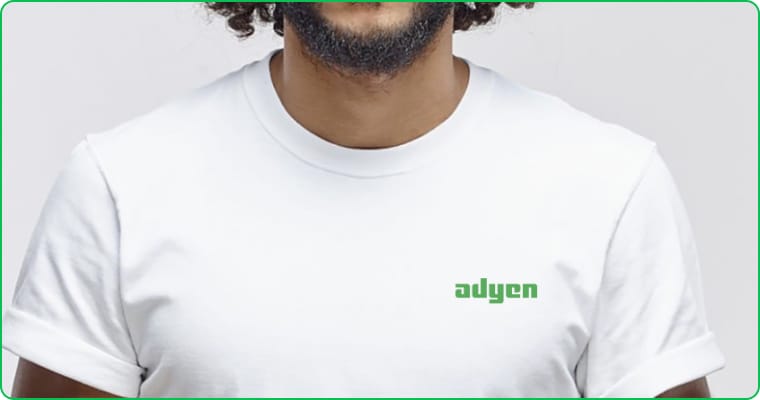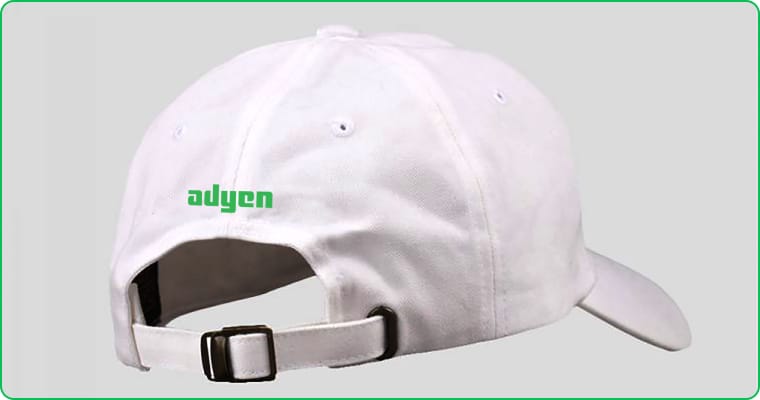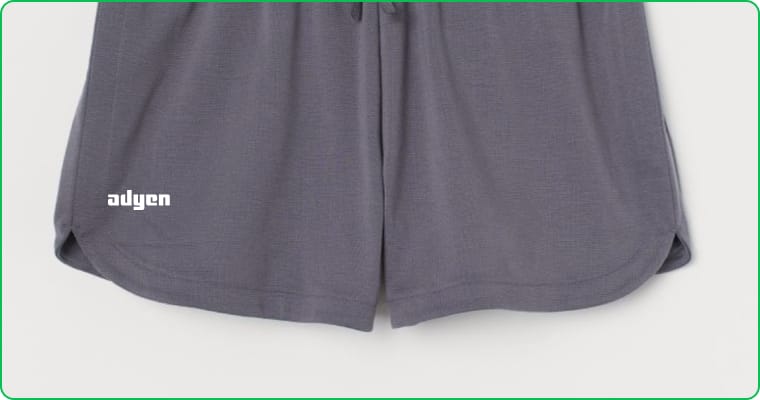Adyen Giving
Above all – does this apparel enhance the event? Should this money be spent more wisely? Have you thought about the impact of the clothing industry? Could this be an Adyen Giving idea instead? Before you brief the studio have a read of the environmental and societal impacts of cotton and dyes.
Merchants first
We always try to support our merchants first, we have a plethora of merchants available to us with incredible products and experts in all kinds of apparel. Let’s leverage that. For example partnering with The North Face, Patagonia, or UNIQLO.
Patterns
We don’t create or print nonsensical or random patterns. We do print graphics related to the event or theme; always check and have these approved by the studio.
Gifiting
We don’t gift apparel to merchants, we do create specialized apparel for RFPs if it supports or adds to the RFP Pitch.
Colors
Our green is super impactful in the digital and print space, as it is very controllable with printing and screens. But unfortunately fabrics and dyes are harder to control. It’s more difficult to match colors and keep consistency. We all have different skin tones and this affects how we look in our colors. Some colors like our Adyen green, do not complement most skin tones. Here are some colors we do like to wear:

Keep up the good work.

Try again.
Logo placement & size
Preferably on a tag or tab stitched in the designed place, this is better as the logo does not stretch when on stretchy fabrics. On t-shirt - If it must be printed then printed no larger than 5cm on the front chest on the wearers right, roughly 7cm from the seam of the sleeve.
Do's & Dont's

We are humble and classy.
.jpg)
Refrain from printing our logo big.

On stretchy material use a lable so the logo doesnt stretch.
.jpg)
Never on a backpack or laptop bag, this is a security risk.

On the back.

Sports Shorts – bottom on wearers right.
Printing types
There are many ways to print on your t-shirt with varying degrees of quality depending on the fabric and the inks used. Always discuss this with amdesigner to help make the best and most sustainable choice.
Fabrics
We don’t do cotton or organic cotton , we do Recycled cottons, bamboo, Recycled or residual cotton, Viscose, modal and rayon, Lyocell (and Tencell), (Organic) hemp, (Organic) linen , (Organic) bamboo (monocle), Polyester, Recycled polyester or any other new sustainable and low impact fabrics, the list is endless you can always speak to our producers like Browny’s who can help source these.
Fit, sizes & styles
Always choose a unisex option, this makes it easier for ordering and distribution, different brands, regions and companies use different block patterns and methods, we also all have different tastes and are comfortable wearing certain styles, this means you need to be mindful, what is a medium for one might not be for another. Please be sure to get test samples and sizes. Gender is a social construct and some prefer what is considered “male” styles and some prefer what’s considered “female” please. Here is some more on this subject.
Are you winning? A quick guide

Short and simple excite, educate, inspire.
.jpg)
Long text doesn't work due to hair and legibility.

We are proud and undertated, we don’t shout
.jpg)
Do not blow up our icons.
Sustainability & impact
Each year we grow enough cotton to give each person on the planet 18 t-shirts. Not much is natural or vegetable about cotton. 16% of all pesticides globally are used to grow cotton,. 2.5% of farmland is used for cotton (an area ten times the size of The Netherlands) which also involves the use of lots of insecticides and artificial fertilizer.
About half of what it costs to make cotton is spent on toxins. The jerry can are kept at home because the poison is so valuable and once they're empty, reused to store water or food.
Cotton's also a very thirsty plant: 10, 000 liters of water are needed to grow one kilo - so a shirt and a pair of jeans.
Colouring and anti shrinkage treatments make it even worse, requiring even more chemicals (and water), that are extremely dangerous for the cotton farmers.
The World Health Organization calculates that every year, one million cotton workers end up in hospital due to pesticide poisoning. Annually 20,000 to 40,000 people die as a result - including many cotton farmers.
The market is worth billions and in the hands of just a few major players, which is why pesticides have not (yet) been outlawed
The people that grow earn far too little, work excruciatingly long hours and do very grueling work. Suicide is relatively common. Since 1995, around 270,000 Indian cotton farmers have committed suicide among other things due to debts because they had to buy extremely expensive, modified cotton seeds